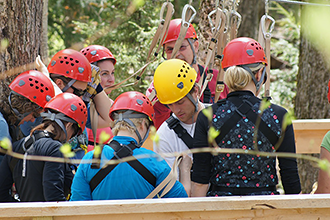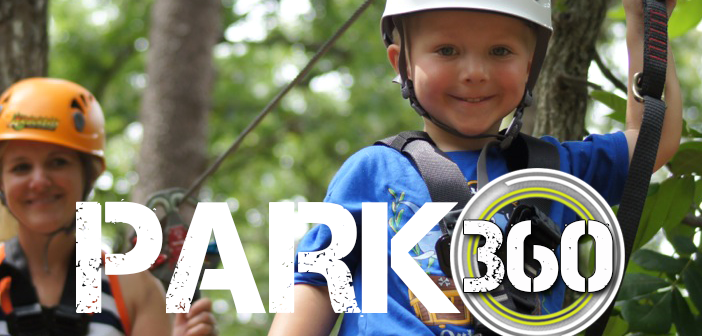A Guided Experience
Smith has worked hard to make sure that Smugglers’ Notch and other ArborTrek sites offer a well-rounded experience that brings people back. To that end, he advocates that the most successful parks invest heavily in staff development and less on infrastructure. An engaging, interactive staff goes a long way in differentiating a park and creating a memory for a guest, he says.
“If the value of the experience is a zipline, and somebody wants to come back and have a new experience, you pretty much have to change the structure,” says Smith. “However, if the experience is coming out and spending a great day in the woods with a guide and your family, that experience is easily adaptable.”

A guided zip line group at Smugglers’ Notch.
At Smugglers’ Notch, Smith says guides are in the business of selling the “Green Mountain Experience,” so they’re trained to be knowledgeable about local activities, can recommend a restaurant, and can discuss a range of topics, from local flora and fauna to how the adventure course was built. He cites Disney as an example, where one ride will have a different spiel each time, depending on the guide. Customers return for the guide, not the activity. It’s this “customizing novelty” that creates return customers.
“There are two different ethoses in the market,” says Smith. “Remove staff and let structure speak for itself or train staff and have a dynamic staff. The tours that are most successful invent heavily in staff, not just infrastructure.”
Colorado-based Vail Resorts has adopted a similar philosophy at its five parks at Heavenly, Calif., and Vail, Colo. The company has retrofitted some elements on its parks, but the real changes can be seen in programming and how products and services are offered.
Last year, marketers at Heavenly took one of its existing aerial courses and chose to sell it in a different way, by adding a guided experience along with its traditional pay-to-play option. Director of Operation, Training and Risk Management Jamie Barrow says this harkens back to the more traditional educational challenge course model on which the aerial park industry was founded.
“We find we get a different clientele with these types of (guided) courses,” says Barrow. “Typically, we’re getting individuals who are reticent to go on an aerial park, whereas pay-to-play they either want to do it or they don’t. We’re bridging the gap between these two types of courses.”
Barrow says though throughput is lower with guided tours, the resort is able to charge a higher price point for the touch of extra support and engagement. After a successful first year, Vail is looking to expand the guided program—which Barrow calls a hybrid concept of a canopy tour and a challenge course—to its other sites.
Teambuilding
Vail Resorts also recently started selling teambuilding experiences through its group sales office. During specified non-peak times, the sales department sells its existing adventures courses to private parties for group challenges. Barrow says this is a great way to get use on the courses during down times and provides greater revenue than walk-up sales.
The team experience is facilitated by resort staff and operates on the principles that there must be a task a group or groups are working together to accomplish. Parks must be adapted in minor ways to accommodate these challenges, like adding removable objects such as foam balls or clip-and-grab money that can be used later at a Casino night. Barrow says these are easy adjustments that a number of third-party vendors could help with, if necessary, and, though Vail hasn’t done it, these types of challenges could easily be incorporated into pay-to-play courses.
When it comes to pay-to-play, Barrow says Vail wants to make sure to expand smartly. “We continually ask ourselves, ‘How do we continue to create more guest interaction points during their time on the course?’ whether that be with a staff member or a family member while doing the activity,” he says. “We want to engage them on more than a physical aspect—we want to create a social and an emotional connection. For us, that goes back to our roots of why we’re even putting these things on—connecting guests and the mountain environment and learning through play.”







